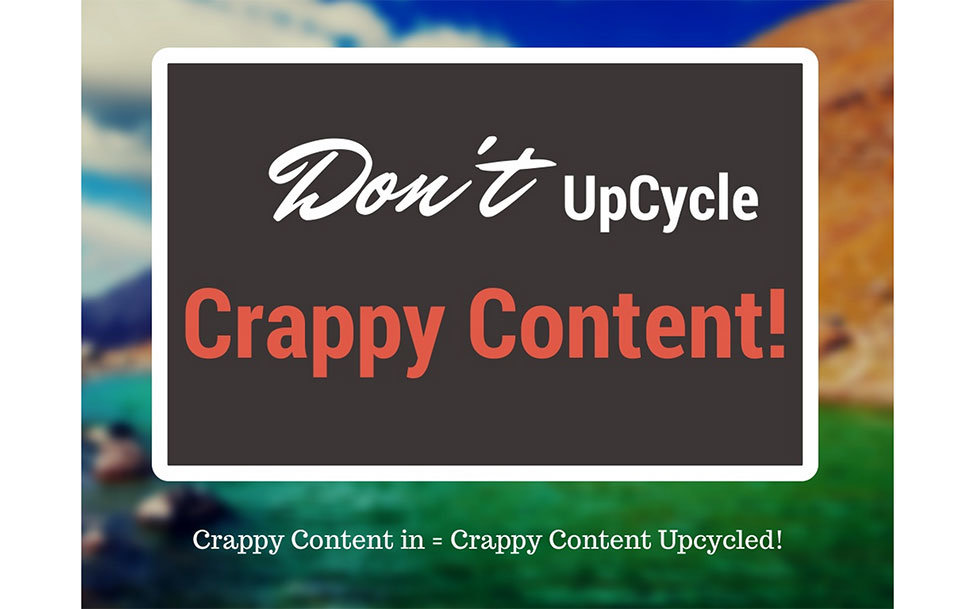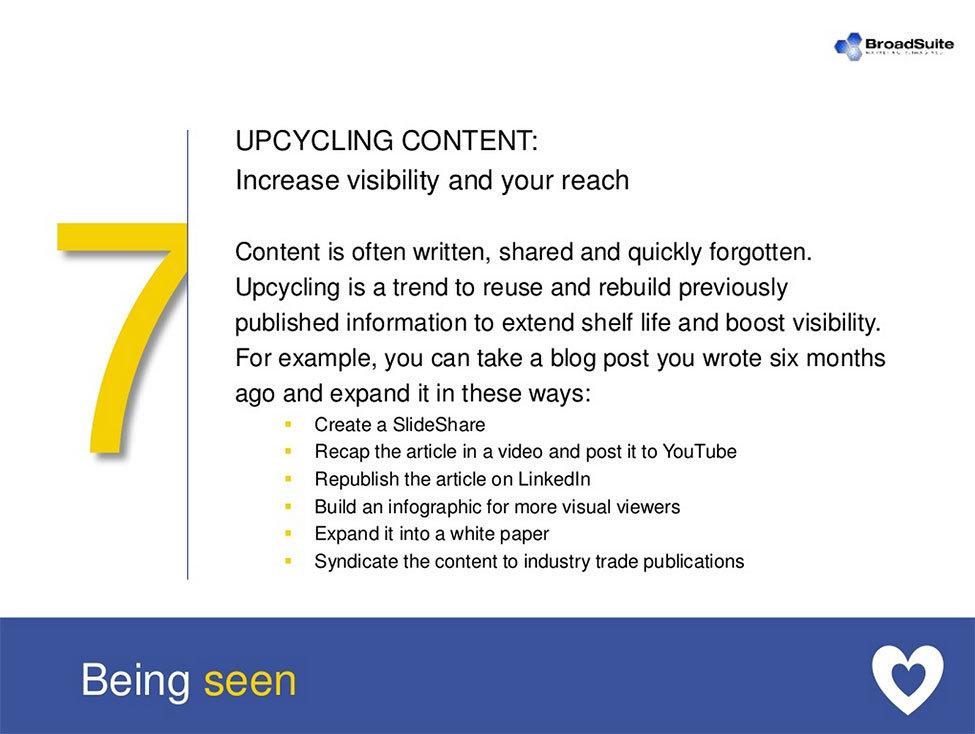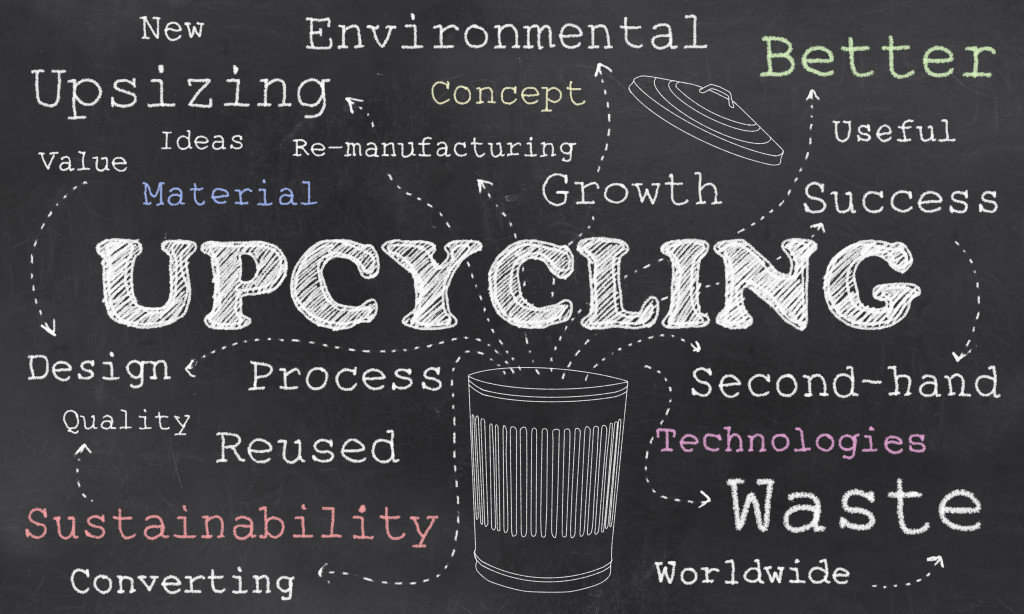To upcycle content is to take components from original content and though creativity transform them into fresh pieces of content across different media and for different content platforms.
Creating content costs a lot of money. Good content which attracts and engages your target audience takes a serious amount of time and investment.
Getting the most out of your content spend is essential in achieving a good ROI on content investment, which is why you should always upcycle content rather starting from afresh each time.
Why Upcycle?
- Content is expensive, so get the most out of it
- Not everyone has the time to consume long form content
- A good piece of content can be upcycled multiple times with little effort
- Ideas are easy, but good ideas are few and far between
- Different types of media can be taken advantage of to reach different types of people
- Upcycling is used to produce new content that is aimed at solving the problem of the user
- It helps by making complex processes simple and more easily understood.
- Upcycling helps explore aspects of the niche in greater detail
- By upcycling you may reveal other aspects of issues that may require further content
- Allows you to drill down and focus on specific aspects of the original content without the distraction of other topics
Most do not employ the tactic of content upcycling, so employing the tactic will give you an edge in the marketplace over your competitors and increase the ROI of your marketing budget.
Many times I have seen companies spend thousands of pounds on an infographic, just to waste that investment by leaving it on a virtual shelf after the initial promotion.
This is wastage.
Focus on getting the most out of your content, there is no need to re-invent content each time. Upcycling will save you time and money.
The Concept
What can you upcycle?
The best content to target for upcycling is long form content that address big, single issues such as “How to make content marketing work for my business?”
Using this as an example you can create numerous pieces of interesting content from it and will give you the fuel to power your social media to allow your tribe to come and warm their hands on the fire you build.

“How to make content marketing work for my business?” is a big question that any business that is considering investing on content marketing has to ask. It’s a common question I am asked when I am brought in to coach the content team of a business and so I know that there are many ways to drill down into the subject to create upcycled content.
Big questions like this are fundamental and can be answered many different ways. Which is important because not everyone would read a 2,000 word article, which is what I would first suggest for answering this question.
The reader needs to be presented with the medium that they are the most comfortable with at that time. The 2,000 word blog post is great for those who have the time to sit still and read, but other people are more distracted and need shorter, punchier, even more visual material.
A Real Life Example of the Benefits of Upcyling
Bob runs a business and commutes 40 mins every day in the car. Because he does not have time to surf the web reading blog posts he loads up on podcasts to listen and learn in the car. He can then learn enough to talk to his internal team about a subject or talk to an outside agency about it.
Whilst listening to the podcast there is little distraction, but there is no way to initiate a click through so the information has to be tailored to reside in Bob’s mind until he can get to an internet connection and perform the action required.
He listened to a podcast that was upcycled from an original blog post the creator wrote on his blog after it had also been upcycled to various other media and published on numerous other social media platforms. Bob remembers enough about the podcast and searches for the name of the author on Google and then clicks through, establishing stronger connection with the brand.
Let’s rewind.
The author wrote the blog post, turned it into a slide deck, created a presentation which was then recorded and published on Youtube, then turned into a podcast. The individual slides were tweeted out over a period of time creating increasing the occurrences of possible connections. The stronger visual images were shared on Pinterest and Tumblr.
Because Bob couldn’t remember exactly the title of the article, he had to Google around. But, because the author had created some many occurrences on the web, the author had increased the chances of being found.
Bob eventually found the original article which contained a strong call to action, which Bob then took. Bob was already primed for the call to action because of all the micro content which had been promoted. The result of which enabled the brand to establish a good connection which resulted in a successful call to action.
Benefits of Upcycling with Social Media
Upcycling is very useful in social media as a promotional component to the main content, because it is very easy to create bite sized pieces of content which can be easily digested. Taking elements of the original content, reformatting in new media and distributing the fresh content around social media accounts.
Places And Methods Where Upcycled Work Can Be Used
- Quora
- Slideshare
- Youtube
- Video intro/outro
- Soundcloud
- Webinar
- Google hangouts presentation
- Tumblr
- Medium
- Facebook group
- Facebook page
- Linkedin status update
- Linkedin page & group
- Tweet
- Twitter profile image
- Snapchat
- Forums
- White Paper
- Ebook for email list
- Kindle book
- 500px
- Contests for user generated content
- Introduction over email for lead generation
Quick Guide to Upcycling to a Slide Deck
- Identify the key points of the content, this should already be done when you roughed out the content
- Put the key points of the content into a PowerPoint
- Find a graphic of image to place as the background
- If you have typographic skills make the text look amazing, if not the background image will carry the visual.
- Give the slide deck a strong title page making sure you cite your name and the name of the website you are promoting.
- Publish on slide share
- Promote on all social media accounts
Some of the slides will be more powerful than others, take the more powerful ones and sprinkle them out via your Twitter account over a period of time. You can automate this part of the process using the Tweetdeck autotweet function.
However if you do this you must be prepared to turn it off if events change.

This is not a fix and forget tactic, you don’t want to be promoting content in the middle of a natural disaster and make you look like an idiot.
Be prepared to rearrange the auto tweets and even stop them.
Tumblr
If you have a tumblr account and you should really only have one if your tribal strategy justifies it. Post a humorous or shocking part of the slide deck. Out of 50 slides you would probably only get one slide that would justify.
This is not about numbers, it’s about quality and increasing the power of your brand.
Tumblr is mad for animated gifs, if you have any video in your content consider turning them into gifs. This requires a bit of technical and editorial knowledge. If you know how to do it, it’s easy, if you don’t it’s very hard. This kind of thing can be easily outsourced.
Youtube
Once made into a PowerPoint or Keynote presentation it is very easy to then turn it into a video. PowerPoint makes it very easy to do these days and there are many other software solutions such as Camtasia where you can record the screen with an audio track.
The slides will cover overviews, or chapter and sub-chapter headings. Your audio will cover the body content. If you are upcycling an article this is simply a case of reading out the article and matching it up with the slides.
We don’t need the video to win an Oscar, most of the visual design work has already gone into the slide images and text.
Another way to do this if the content is strong enough is to host a webinar on Google hangouts. If you have a following or are part of a tribe which is interested in the specific issue you are addressing and they should be else why create content around it, then you can live broadcast your slide deck and present it with people watching and record this.
Yes, this is scary and intimidating, but the content you have created should be strong enough to present to people interested in the subject and doing this will help if your quest is to become a leader in your niche.
Live presenting helps inject an energy into the presentation that may not be there if you are going solo, it also helps by forcing you to a deadline and giving you a big reason not to get distracted.
Google hangouts is great for this as you can record it on the Youtube system and then publish it after editing.
You may find that you also pick up business this way and strengthen any connections you have with your tribe.
Conclusion
Why we don’t Upcycle.
Because we get bored with the subject, we want to move on to the next interesting bit of content and try out a new thing. But you are not a content creator to interest yourself, you are creating content to build brand, to sell stuff. You create content to do stuff, not to be entertained.
It can be a grind going through the process of upcycling, so consider outsourcing it. Once you have done the fun part and create the original content you can quite easily and quickly pay others to do it for you. And if you chose people who are expert in their field, they will do it a lot better than you.
At the end of the day, to upcycle is to pick the low hanging fruit, mostly because everyone is not yet doing it.
Photos: 1, 2, 3

 Site Explorer
Site Explorer Keyword tool
Keyword tool Google Algorithm Changes
Google Algorithm Changes


Leave a Reply!